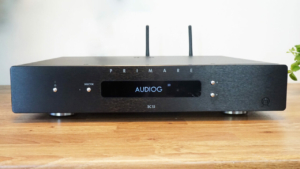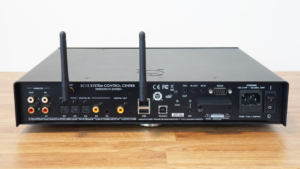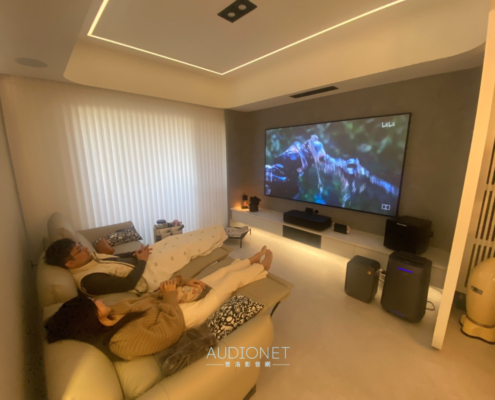[器評] 瑞典PRIMARE Audio Grade:SC15 Prisma「數位串流前級擴大機」2022年最佳產品
正如我們最近的評論所證明的那樣,高品質高傳真音響不再只是工業尺寸分離式揚聲器和傳統被動揚聲器的象徵。通常,我們現實世界的家庭和聆聽偏好意味著我們的系統需要融入我們的周圍環境,而不是與之競爭。
一些製造商比其他製造商更了解這一點,這讓我們精心挑選了一種系統,可以最大限度地減少盒子數量和貨架空間,同時又不影響聲音和功能。 Primare 向前邁進,以其典型的瑞典低調方式在風格、品質和用戶體驗方面享有盛譽。

Minimal front panel controls for standby, selection and menu plus elegant customisable screen are pure Scandi minimalist
小巧動人
我們選擇的套件中的核心 SC15 Prisma 前級放大器取自該品牌更緊湊的 15 系列,其中還包括售價 1,650 英鎊的 CD/網絡播放器和售價 1,700 英鎊的 I15 MK2 集成放大器/網絡播放器。 SC15 本質上與後者型號相同,但去除了 60W Hypex 內部功率放大器部分,並用 AKM DAC 晶片代替了集成的 ESS 功能,從而將價格標籤降低到 150 美元。

還有鈦銀飾面可供選擇,請注意 Primare 的商標擠壓前面板。隨附的遙控器放大了 SC15 的縮小尺寸,尺寸為 350x330mm(寬x深)
您得到的是一個圍繞Primare 多功能Prisma 串流媒體模組構建的設備,我們上個月在NP5 Prisma Mk2 串流媒體中評測過該模組,與AKM AK4490 DAC 晶片相結合,可在紙上提供高達32 位元/ 384kHz PCM 的資料(儘管實際上它可以處理高達 768kHz),透過 USB-B 處理 DSD5.6/128,透過光纖和 USB-A 處理 192kHz 和 DSD128。
提供 AirPlay 2、Chromecast、Spotify Connect、Tidal、Qobuz 和藍牙的串流服務。至關重要的是,WiSa wifi 發射器也是包裝的一部分,允許該裝置透過 wifi 與其他配備 WiSa 的套件(包括揚聲器)連接,因此無需揚聲器電纜。類比輸入和輸出僅是線路電平(透過 RCA),但在這個價格上,不期望平衡連接是公平的,這也釋放了後面板空間需求,有助於保持設備緊湊。
遙控器是包裝的一部分,儘管由 Primare 的 Prisma 應用程式發號施令,但它更可能是備用選項,而不是您的常用操作方式。

輸入包括一對類比 RCA、四個光纖(一個共享為 3.5 毫米類比)、一個同軸、USB-A/B 和乙太網路以及藍牙和 WiFi 天線。輸出僅限於數位同軸插座和單組類比 RCA。請注意電源輸入左側的 WiSa 模組和配對按鈕。
了解更多:Audio Grade 2022年最佳產品 查看全文
The only way is up?
能夠在可變或固定輸出模式下運行SC15 意味著其前級擴大機的職責已經成熟,並延續了極簡主義主題,有源揚聲器是其理想的生活方式夥伴,因為內建功率擴大機意味著更少的盒子,同時也確保其驅動單元得到精確控制正如製造商的意圖。
System Audio 揚聲器來自丹麥羅斯基勒,是 Primare 理想的北歐夥伴,提供一系列屢獲殊榮的主動和無線型號。 SA Legend 7.2 Silverback 聽起來像是23 世紀國家大獎賽的冠軍,但它實際上是標準Legend 7.2 的主動版本,帶有內部WiSa 接收器和三個組合DSP/DAC 放大器,SA 將其稱為“功率DACS” ,總功率為 225W。
揚聲器的雙5.5 英寸(140 毫米)中/低音單元由碳纖維膜製成,而隨附的1 英寸(25 毫米)高音揚聲器為軟圓頂型,凹進倒角DXT 聲學透鏡內,以在整個揚聲器中提供更均勻的高頻分佈。

這些揚聲器的主要特點是用戶靈活性,後面板內建嵌入式壁掛支架,如果您想將它們安裝為「橫向」或「縱向」方向,則包含兩組格柵,這意味著它們所有重要的徽標都將是正確的方向。
雖然我們選擇了其中兩個揚聲器將它們配置為立體聲模式,正如 7.2 綽號所暗示的那樣,但您也可以添加更多揚聲器並將它們配置為 7.1 家庭劇院設定。每個揚聲器單獨提供,成本為 ,系統的總體價格為 。
儘管他們的櫥櫃在櫥窗中看起來可能不是最時尚的,但它們的前面板和後面板均由 25 毫米 MDF 部分堅固製成,周圍表面則採用 18 毫米 MDF。它們也經過倒角處理,後面板比前面板稍大,使它們看起來比其 47 x 27 x 16 公分尺寸 (WHD) 所建議的要小。

Sturdy recessed rear brackets highlight a range of mounting options, with cable channels for every option
Good to go
有了兩個不同品牌的套件和一個主要是虛擬的設置,我對配置應用程式幾個小時的絞盡腦汁和困惑的擔憂很快就消失了,因為值得慶幸的是,系統的啟動和運行很容易。從Primare 開始,您可以從前面板介紹畫面中選擇電纜(就像我所做的那樣)或wifi,後者只需要您先使用Google Home 應用程式將Primare 連接到您的本地網絡,然後Prisma 應用程式會看到它。透過乙太網路進行硬連線甚至更簡單,因為 Primare 的 Prisma 應用程式會自動找到裝置。
這是一個多麼棒的應用程式。與 Primare 的舊應用程式相比,Prisma 給人一種下世紀的感覺。如果您希望根據自己的喜好進行自訂,則可以輕鬆同步到您的串流媒體帳戶,還可以進行命名輸入、自動音量等級和前面板亮度控制的進一步設定。

SA 揚聲器也有自己的應用程式 (SA Cockpit),它提供配置和調音選項,儘管這對於讓它們工作並不是必需的。只需打開它們的電源,然後使用後面板按鈕選擇每個裝置在立體聲或環繞聲設定中的位置,然後按住即可進行配對。現在點擊 Primare 和 bingo 背面的配對按鈕,SC15 的前螢幕會確認連接,然後就可以開始了。
為了節省在剛抹灰的 7x4m 聽音室中鑽孔的麻煩,我將揚聲器安裝在支架上,後面板與牆壁齊平,水平放置,相距 1.8m,並沿較長的軸發射。

性能
從 Elton John 的《火箭人》(Rocket Man) 在 Tidal 上以 16 位元/44kHz 傳輸的開場小節可以清楚地看出,該系統的尺寸並沒有限制其聲音。 SA 揚聲器所帶來的音樂規模和聲場立即消除了人們對它們只是衛星音箱的先入為主。對於這種尺寸的揚聲器來說,低音傳遞非常出色,從合唱開始時行走的低音吉他如何邁出步伐就可以看出,這表明它們不僅沒有問題,不僅可以向下延伸到他們聲稱的35Hz(+ /-1.5dB),而且還確保它們產生的較低頻率比其樸素的驅動器和箱體所建議的具有更大的重量和存在感。
調整揚聲器的靈敏度選項可為您提供更多選擇。在我的聽音室中,後靈敏度設定為 0dB 可提供最佳平衡,-6dB 使聲場中的低頻有點過於突出,而 +6dB 則有點過於傾斜。
透過Qobuz 播放凱特布希(Kate Bush) 的Running Up That Hill (A Deal With God) 的24 位/44kHz 重製版,迎合當前的音樂時代精神,突出了這首歌應該如何被聆聽,與目前通過每個頻道播放的數量形成鮮明對比。
Sonic synergy
Primare 和 SA 組合的協同作用真正發揮了作用,儘管鼓的錄製方式故意具有迴聲性質,但仍以極低的懸垂水平捕捉打擊樂的時機。該系統還透過這首曲目展示了它可以聚集的聲場深度,打擊樂從我的牆後面傳來,就像在另一個維度一樣。
雖然這是一個很大程度上基於數字的系統,但它的音樂特徵與音樂有著豐富的相似性,音樂的溫暖感幾乎像黑膠唱片一樣。 Nick Drake 的《Five Leaves Left》專輯中的《Three Hours》透過 Qobuz 以 24/96 PCM 進行串流播放,與我習慣透過 VPI 黑膠前端聽到的相比,它的氛圍幾乎沒有丟失。吉他作品充滿了細節,為我提供了一個了解它的演奏方式的窗口,而不僅僅是最終的聲音。每根拉長的吉他弦都會隨著德雷克(Drake)更加用力地彈撥而毫不費力地表達出來,而在通常需要它的段落中,嘶嘶聲則被很好地抑制住了。整體而言,給人的印像是令人信服地自然再現原作,而不是劣質的數位詮釋。
總結來說
該系統強調的是高傳真音響的邊界如何正確發展以滿足現實世界的需求。當結合起來時,Primare 的 SC15 前端和 SA 的 Silverback 揚聲器將在聲音和可用性方面輕鬆地以相似的價格點與傳統的雙通道系統進行競爭,因為這兩種產品的基礎質量都沒有受到影響。
拋開您的成見,如果您在市場上尋求靈活的解決方案而不需要大量的盒子,那麼 Primare 和 SA 組合值得您關注。

技術服務諮詢
M&K Sound台灣總代理 愷銳音響 台北總公司
地址:台北市信義區信義路六段22號2樓 | 電話:02-2726-1286
台中展示中心
地址:台中市西屯區台灣大道三段709號 | 電話:04-2258-1918
















